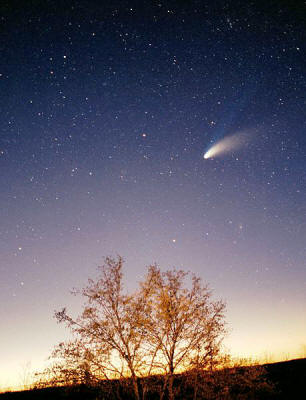|

by Nicholas West
December 8, 2012
from
ActivistPost Website

Last Great Comet Hale-Bopp (1997)
Wiki image
Some ancient cultures referred to them
as "the Menace of the Universe" and "the Harbinger of Doom." Comets
have almost universally been viewed by the ancients as messengers or
omens carrying bad news from the gods.
In the midst of our busy lives it's difficult to keep in mind that
we reside on a ball that's corkscrewing through space around a ball
of gas called our sun, which is also sweeping through our galaxy.
The ancients didn't have distractions like TVs and the Internet.
They looked to the sky for clues and guidance for life on Earth, and
comets brought mythology of angry gods and instilled fear in them.
Strangely, in more modern times, comets have been associated with
actual dark events.
According to
NASA:
Comets' influence on cultures is not
limited simply to tales of myth and legend, though.
Comets
throughout history have been blamed for some of history's
darkest times. In Switzerland, Halley's Comet was blamed for
earthquakes, illnesses, red rain, and even the births of
two-headed animals.
The Romans recorded that a fiery
comet marked the assassination of Julius Caesar, and another was
blamed for the extreme bloodshed during the battle between
Pompey and Caesar. In England, Halley's Comet was blamed for
bringing the Black Death.
The Incas, in South America, even
record a comet having foreshadowed Francisco Pizarro's arrival
just days before he brutally conquered them.
Comets and disaster became so
intertwined that Pope Calixtus III even excommunicated Halley's
Comet as an instrument of the devil, and a meteorite, from a
comet, became enshrined as one of the most venerated objects in
all of Islam.
Although comets are not uncommon in our
solar system, Great Comets only appear once a decade on average.
There's is no major significance about
the size of "Great
Comets", rather they are simply defined as comets that become
exceptionally bright and can be seen by casual observers with the
naked eye.
This usually has to do with their
distance from Earth.

Comet types depicted
as daggers
So what are we to make of the
possibility of two Great Comets flying by Earth in 2013?
Astronomers have discovered two new comets that are fast approaching
our planet and have the potential to be Great Comets.
The first comet, named
C/2011 L4 (PANSTARRS), is expected to make
its arrival in March 2013.
According to astronomers, it will be,
"potentially visible to the naked eye low in the western horizon
just after sunset" and also has the "potential that it may be
visible during the day."
Richard Wainscoat, an astronomer at the University of Hawaii who
co-discovered the comet, claims there is no danger of collision with
Earth but admits,
"since we don't have a lot of data on it, we really
don't know the orbit well enough right now."
The second comet, the one which could possibly outshine the Moon,
was only just discovered this September and is called C/2012 S1 (ISON).
Astronomers predict,
"current orbital predictions indicate the comet
will look brightest to us in the weeks just after its closest
approach to the sun, on November 28, 2013."
Comet ISON may be visible for the last two months of the year as
well as early 2014 and is the more likely of the two to be a
spectacular event:
The comet is already remarkably
bright, given how far it is from the sun, astronomer Raminder
Singh Samra said. What's more, 2012 S1 seems to be following the
path of the Great Comet of 1680, considered one of the most
spectacular ever seen from Earth.
'If it lives up to expectations,
this comet may be one of the brightest in history,' said Samra,
of the H.R. MacMillan Space
Centre in Vancouver, Canada.
(Source)
This comet is considered to be larger
than most at 3 kilometers wide (roughly 2 miles) adding to the
anticipation of its arrival. It, too, may be visible during the day
according to astronomers.
The last Great Comet highly visible from Earth, Hale-Bopp, arrived
16 years ago in 1997.
So we are long overdue considering the average
of one-per-decade. Although very little major news occurred in 1997,
the last 16 years have been perhaps the most tumultuous in human
history from
9/11 and the
war on terror to a
devastating financial
collapse, both of which have still not peaked.
Astronomers are cautious not to make wild predictions about
approaching comets, always adding the caveat that they never really
know how comets will react as they get closer to the sun. Yet, it
does seem significant that 2013 may have two Great Comets.
Will one of them be a "Harbinger of Doom" and bring dark times with
it? As the world braces for the end of the much discussed Mayan
Calendar on December 21st, 2012, these comets only add more intrigue
to cosmic conspiracies.
The authorities and media downplay "end of the world" talk which is
probably the responsible thing to do to stave off panic. However,
it's increasingly difficult to know where to find the truth.
And NASA isn't exactly known for its
honesty either, sometimes being referred to as "Never
A
Straight Answer".
Even if we won't get a straight answer from NASA, we should heed the
advice they gave to their staff to be prepared to survive potential
emergencies:
A major initiative has been placed
on Family/Personal Preparedness for all NASA personnel.
The
NASA/Family Preparedness Program is designed to provide
awareness, resources, and tools to the NASA Family (civil
servants and contractors) to prepare for an emergency situation. The most important assets in the
successful completion of NASA’s mission are our employees’ and
their families.
We are taking the steps to prepare our
workforce, but it is your personal obligation to prepare
yourself and your families for emergencies.
(Source)
|


